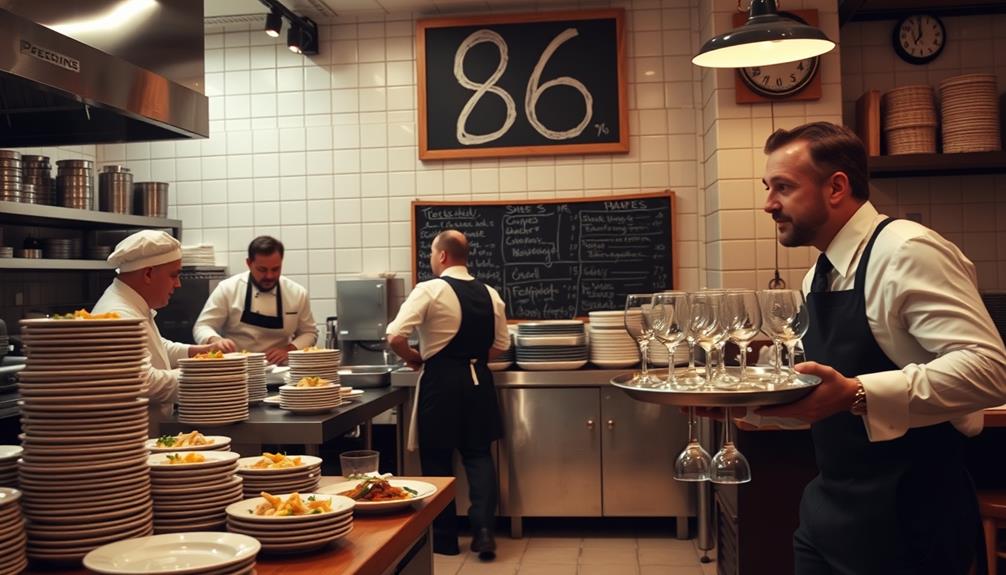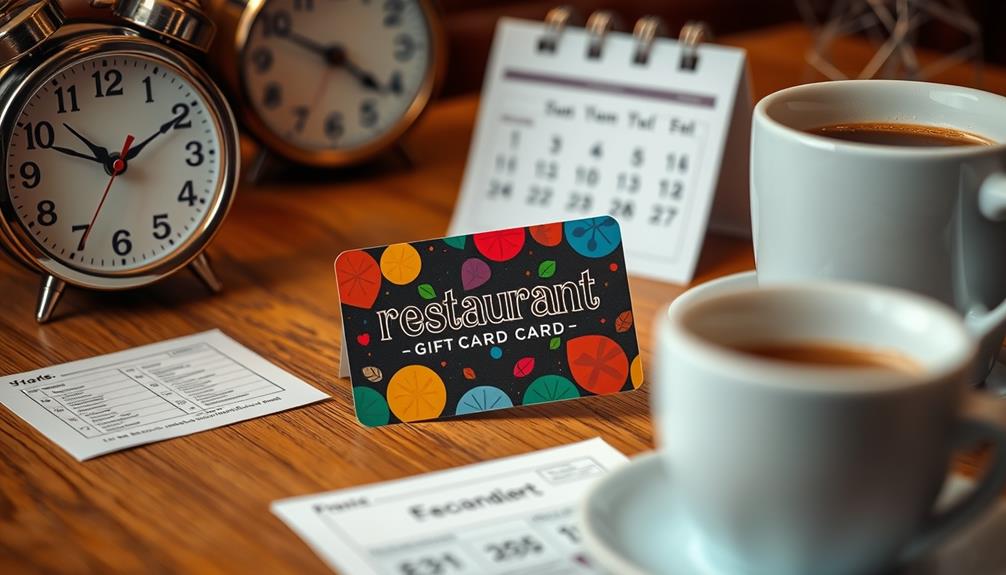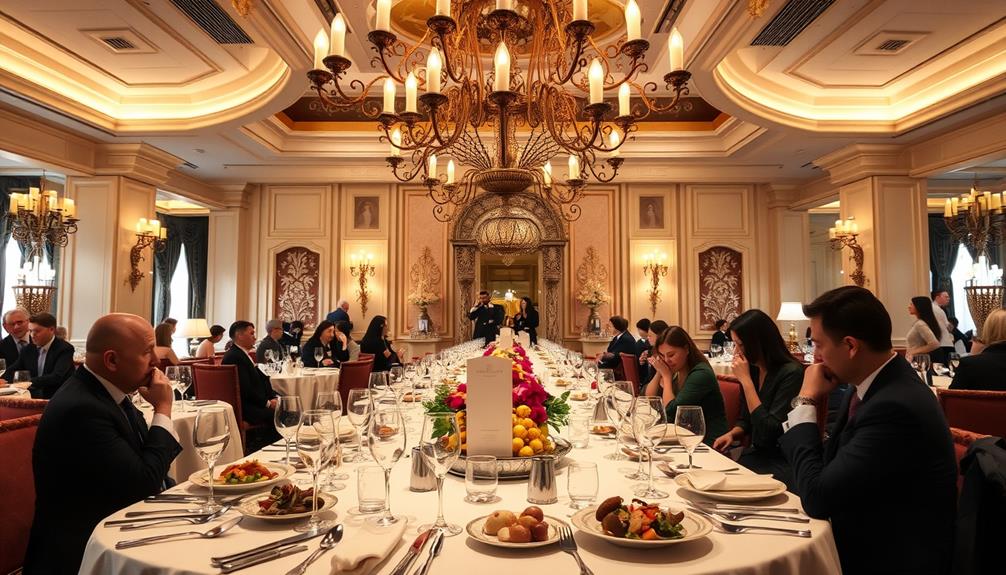Restaurants say "86" as a quick way to let staff know that a menu item is out of stock. This slang originated in the 1930s and has roots in the Prohibition era, where it possibly referred to removing rowdy customers from Chumleys bar at 86 Bedford Street. It helps maintain efficient communication among the team, ensuring smooth service. Commonly, perishable items or seasonal dishes are often 86'd, impacting your dining experience. A restaurant's ability to manage inventory effectively can affect your overall satisfaction. Explore further to uncover more about this unique culinary language and its significance!
Key Takeaways
- "86" originated in the 1930s as slang for items that are no longer available on the menu.
- It serves as a quick communication tool among restaurant staff to indicate unavailable dishes.
- The term may have roots in Prohibition, signifying the removal of unruly customers from Chumleys bar.
- Frequent 86ing can frustrate customers and impact their overall dining experience and loyalty.
- Effective inventory management and clear communication help minimize the occurrence of 86'd items.
Definition and Origin of 86

The term "86" has its roots in the 1930s restaurant scene, where it emerged as slang to signal that a kitchen has run out of a specific menu item. In the fast-paced world of restaurants, clear communication is essential, and "86" serves as a quick way to inform staff about unavailable dishes. This term often arises due to ingredient shortages or spoilage, allowing the kitchen to operate smoothly.
Curiously, the origin of "86" may also tie back to Chumleys bar at 86 Bedford Street during Prohibition. Bartenders used the term to "86" unruly customers, preventing potential issues with law enforcement. Over time, the term evolved beyond just menu items; it now signifies the act of refusing service or discarding something altogether.
In addition, efficient communication is significant in various industries, including healthcare, where professionals must quickly convey important information to guarantee patient safety, as seen in cold medications overview.
In the restaurant industry, adopting "86" improves operational efficiency by streamlining communication among staff. This reflects broader cultural shifts and adaptations in language, especially within dining and bar sectors.
Impact on Customer Experience

When diners encounter an 86'd item on the menu, it can greatly impact their experience. You might feel frustration or disappointment, especially if you'd your heart set on a specific dish. Frequent 86ing can lead you to question the reliability of the restaurant, and that can seriously hurt customer satisfaction.
Understanding the importance of effective budgeting techniques can help restaurants manage their inventory better.
Consider this scenario:
- You walk in, craving your favorite dish.
- You see it's been 86'd, and you feel let down.
- You scan the menu for alternatives but find nothing appealing.
- You leave, contemplating whether to return in the future.
If a restaurant consistently 86s popular items, it can deter your loyalty and make you seek other dining options.
However, effective inventory management can turn this around. By minimizing 86ing, restaurants can enhance overall customer satisfaction. Clear communication about unavailable items, along with enticing alternatives, can help maintain goodwill.
This way, even if your preferred dish isn't available, you still feel valued and appreciated as a customer. Ultimately, how a restaurant handles 86ing can markedly shape your dining experience and influence whether you'll return for more.
Commonly 86d Menu Items

You might be surprised to learn that some menu items are more likely to be 86'd than others. In the restaurant industry, perishable goods like leafy greens and fruits often find themselves on the chopping block due to their limited shelf life.
Additionally, certain ingredients may become scarce based on seasonal availability, which can directly impact menu offerings and customer expectations. Seasonal dishes, which rely on fresh ingredients, also get 86'd when supplies run low.
Limited-time specials are another prime candidate; once they run out, they're gone, creating a sense of urgency for patrons.
Understanding caffeine levels in coffee can mirror how restaurants gauge demand for their best-selling items. Prepared items, such as breakfast burritos or daily soups, may be 86'd as demand sometimes outstrips what's available.
When inventory mismanagement occurs, popular items can be frequently 86'd, leading to customer frustration and missed sales opportunities.
To combat this, restaurants benefit from consistently tracking their best-sellers. This practice helps them anticipate demand and minimize the chances of commonly 86'd menu items disappearing from the lineup.
Inventory Management Strategies

To keep your menu items from being 86'd, effective inventory management strategies are key. By implementing these strategies, you'll guarantee popular dishes are always available and minimize shortages that lead to frustrated customers.
High-quality content and accurate data analytics can further enhance your approach to inventory management, as they help you better understand customer preferences and trends in your offerings. By integrating holistic SEO practices, restaurants can also improve their online visibility, attracting more customers who are enthusiastic to try their favorites.
- Real-time tracking: Use POS technology to monitor ingredient usage and forecast demand accurately.
- Designated oversight: Assign a responsible person to manage inventory, guaranteeing timely orders from reliable suppliers.
- Data analytics: Streamline your ordering process and analyze customer preferences to adjust your menu and inventory accordingly.
- Simplified menus: Consider offering smaller, focused menus to reduce complexity and better control ingredient usage.
Cultural Significance of 86

In bustling restaurants and lively bars, the term "86" acts as an indispensable signal among staff, indicating the removal of a menu item. This shorthand, originating in the 1930s, showcases the evolving language of the food service industry, enhancing communication efficiency during peak hours.
Its roots trace back to the Prohibition Era, particularly linked to Chumleys at 86 Bedford Street, where quick exchanges were essential in a clandestine environment. As in any relationship, effective communication is significant, and understanding such terms can help foster collaboration and resolve conflicts, much like strategies to navigate partner shutdown.
The phrase's cultural significance extends beyond the kitchen. "86" has permeated popular culture, appearing in films and music, which highlights its adaptability and relevance. You might even notice how its usage reflects societal attitudes toward service and hospitality.
The term carries a hint of dark humor, suggesting finality—like a dish being buried—while also emphasizing the need for staff camaraderie and swift decision-making.
Ultimately, "86" serves as a reflection of the unique language that develops in fast-paced environments, fostering a sense of belonging among those who work behind the scenes. By understanding this quirky term, you gain insight into the rich tapestry of restaurant culture and its historical roots.
Frequently Asked Questions
Where Did the Term 86 Come From?
The term "86" likely originated from Chumleys bar in the 1930s, where it signified being out of an item. It's also connected to whiskey proofing and possibly even grave dimensions, emphasizing refusal or removal.
Why Do Restaurants Use the Number 86?
Think of a restaurant as a bustling train station. Restaurants use 86 to signal that an item's no longer available, keeping everything running smoothly and ensuring you enjoy an efficient dining experience without unnecessary delays.
What Does 68 Mean in a Restaurant?
In a restaurant, "68" means an item is back on the menu or available again. It signals to the team that a dish is ready for service, ensuring everyone's on the same page.
What Does 86 Mean Urban Dictionary?
When the chips are down, you'll find "86" in Urban Dictionary means to remove something from availability. It's a restaurant shorthand for saying an item's gone, helping staff communicate quickly and efficiently.
Conclusion
Next time you hear a server say "86," remember it's more than just a code—it's a lifeline for a smooth dining experience. This quirky term not only streamlines operations but also enhances your enjoyment by keeping the menu fresh and exciting. Whether it's a beloved dish or an ingredient, knowing what's off the table adds an element of anticipation to your meal. So, embrace the mystery of 86 and let it spice up your next restaurant adventure!









